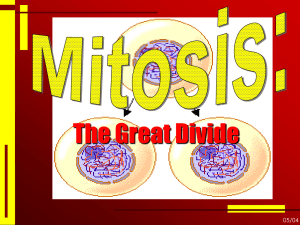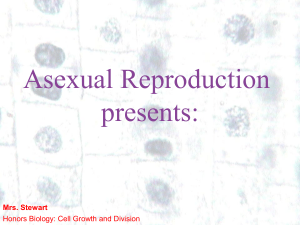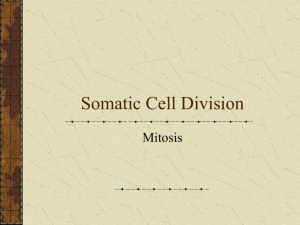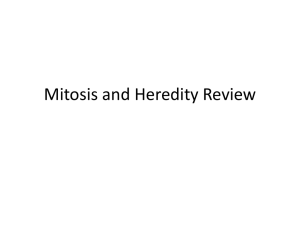Cell Cycle, Mitosis, and DNA replication Test Review—turn in this
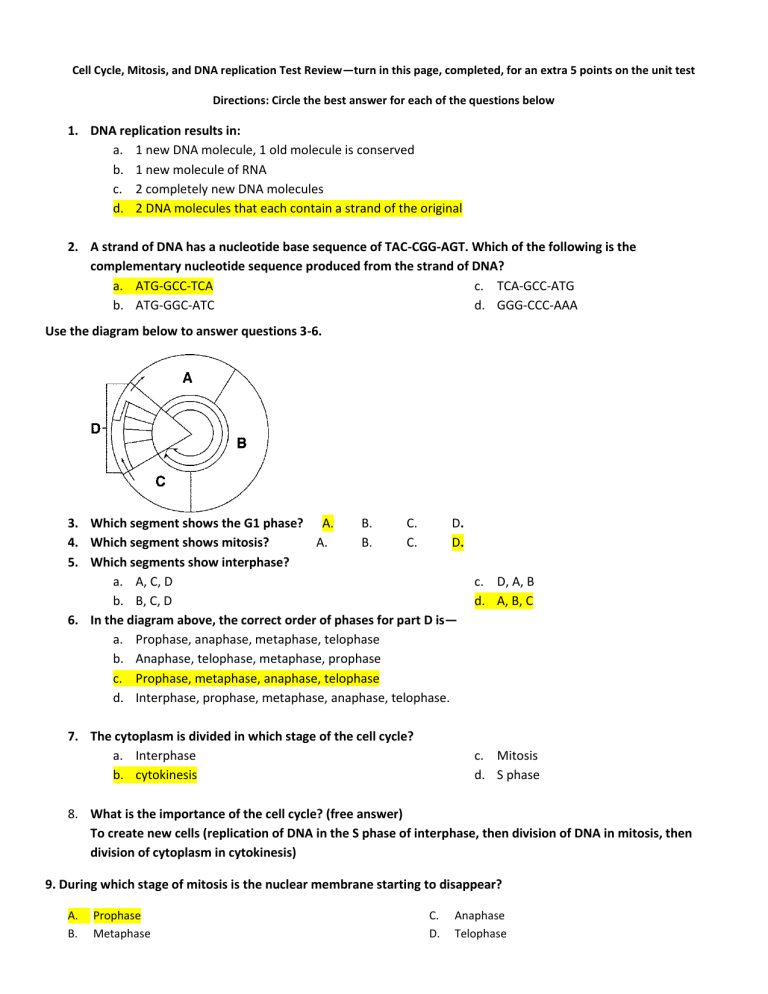
Cell Cycle, Mitosis, and DNA replication Test Review—turn in this page, completed, for an extra 5 points on the unit test
Directions: Circle the best answer for each of the questions below
1.
DNA replication results in: a.
1 new DNA molecule, 1 old molecule is conserved b.
1 new molecule of RNA c.
2 completely new DNA molecules d.
2 DNA molecules that each contain a strand of the original
2.
A strand of DNA has a nucleotide base sequence of TAC-CGG-AGT. Which of the following is the complementary nucleotide sequence produced from the strand of DNA? a.
ATG-GCC-TCA b.
ATG-GGC-ATC c.
TCA-GCC-ATG d.
GGG-CCC-AAA
Use the diagram below to answer questions 3-6.
3.
Which segment shows the G1 phase? A. B.
4.
Which segment shows mitosis?
5.
Which segments show interphase?
A. B. a.
A, C, D b.
B, C, D
C.
C.
6.
In the diagram above, the correct order of phases for part D is— a.
Prophase, anaphase, metaphase, telophase b.
Anaphase, telophase, metaphase, prophase c.
Prophase, metaphase, anaphase, telophase d.
Interphase, prophase, metaphase, anaphase, telophase.
D.
D. c.
d.
D, A, B
A, B, C
7.
The cytoplasm is divided in which stage of the cell cycle? a.
Interphase b.
cytokinesis c.
d.
Mitosis
S phase
8.
What is the importance of the cell cycle? (free answer)
To create new cells (replication of DNA in the S phase of interphase, then division of DNA in mitosis, then division of cytoplasm in cytokinesis)
9. During which stage of mitosis is the nuclear membrane starting to disappear?
A.
Prophase
B.
Metaphase
C.
Anaphase
D.
Telophase
10. The number of chromosome pairs in a human cell is 46. How many chromosomes would be in each daughter cell at the end of Mitosis?
A.
23
B.
22
C.
48
D.
46
11 During which stage of mitosis do sister chromatids separate to form two sets of chromosomes?
A.
Anaphase
B.
Interphase
12. Which stage of mitosis is depicted in the diagram below?
C.
Prophase
D.
Metaphase
A.
Anaphase
B.
Metaphase
C.
Telophase
D.
Prophase
13. The interphase, mitosis, and cytokinesis together constitute the cell cycle.
A.
True
B.
False
14. Which stage of mitosis is depicted in the diagram below?
A.
Telophase
B.
Metaphase
C.
Anaphase
D.
Prophase
15. In mitosis, when is the nuclear membrane formed around the new set of daughter chromosomes?
A.
Prophase
B.
Metaphase
16. DNA replication results in: (5C)
C.
Telophase
D.
Interphase a.
2 completely new DNA molecules b.
2 DNA molecules that each contain a strand of the original c.
2 old DNA molecules d.
1 new molecule of RNA
17.
Which of these are the units that form a DNA molecule? (5C) a.
fatty acids b.
nucleotides c.
amino acids d.
chromosomes
18. Hemoglobin is an important protein in red blood cells. The DNA code for hemoglobin contains the following segment:
TGC-GGA-CTC-CTC
Which of these is complementary strand for this segment of DNA? (6C) a.
ACG-CCT-GAG-GAG c. ACG-CCU-GAG-GAG b.
TCC-GGT-CTC-CTC d. UGC-GGA-CUC-CUC
19.
Use the diagram below to answer the following question.
Which of these is a nucleotide? (5C) a.
1 b.
2
20. Cell division is represented in the figure below by the letter
c. 3
d. 4 a. A. b. B c. C d. D
21. Which of these represents the structure of DNA?
A B
C D
22. What cellular process does the picture to the right represent? a.
Replication b.
Transcription c.
Translation d.
Mitosis
23. Cancer cells- a.
Divide uncontrollably and die quickly b.
Are particularly sensitive to extracellular messages c.
Divide uncontrollably and may cause masses of cells d.
All of these
24. Amylase is an enzyme that allows the human body to digest starch. Which of these diagrams best represents part of the structure of the enzyme amylase?a. b. c. d.
25.
The diagram below shows a molecule made up of carbon, hydrogen, and oxygen. What is the name of the monomer that correctly identifies this structure? a.
amino acid b.
sugar c.
starch d.
nucleotide
26.
The diagram below is composed of one glycerol and three fatty acid tails. This structure allows for which biomolecule to be made? a. Nucleotides b. Carbohydrates c. Lipids d. Proteins
27.
The diagram to the right shows the structure of a unit that makes up proteins. These smaller subunits that make proteins are called— a.
Amino acids b.
Lipids c.
Nucleotides d.
Monosaccharides
28. Plant and animal cells share many of the same organelles because they are both considered to be eukaryotic cells.
The difference between a plant cell and an animal cell is that animal cells do not have _____. a. a nucleus b. a cell membrane c. chloroplasts d. centrioles

